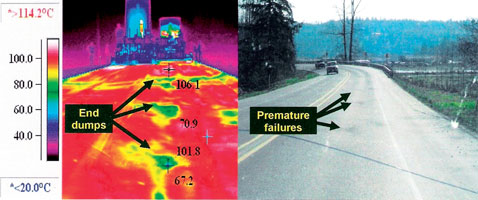
Hot-mix asphalt (HMA) surfaces comprise a high percentage of our highways and roads and are typically engineered to last 15 years or more, but many have suffered premature failure due to potholes, cracks, ravelling and other problems. These failures waste millions of taxpayers' rands every year.
A series of research studies have been conducted in the USA to determine the reason for the premature failure of HMA paved roads. The field studies used infrared thermography and site evaluations to determine the results. Study results confirmed that a major cause of early failure stems from temperature differentials in the hot-mix during laydown.
The first link between pre-compacted surface temperature and HMA density was verified in 1996 when studies were done to investigate 'cyclic segregation' or 'end of load segregation'. These studies confirmed that the clumps of crusted material that went through the paving machine without substantial remixing during end dump operations were relatively cooler than the bulk of the material and therefore stiffer and more resistant to compaction. As a result these areas were relatively porous and filled with air voids, less dense, and less resistant to wear and degradation from traffic and the environment than the surrounding matrix. The study concluded that placement of this cooler hot-mix can create areas near or below cessation temperature (79°C), which tend to resist adequate compaction. Even after aggressive rolling, the isolated cool areas have lower densities, and more air voids, than the surrounding material.

In 1998 an infrared thermal imager was used in studies to correlate temperature difference, aggregate segregation and compacted densities. The relatively cooler areas were found to have lower densities than the hotter areas, with an overall air void difference of 1,6 to 7,8%. From this study it was concluded that isolated areas of low density were related to temperature differentials and not to aggregate segregation.
Temperature differential damage occurs when a truck load of HMA exhibiting temperature differentials is dumped into the paver’s hopper. HMA cools along the top and sides of the truck bed. The cool material then falls inward to lay on top of the material over the slat conveyors. When the next truck arrives and dumps into the paver, this cooler material is extruded onto the roadway. This cooler material is placed on the mat in isolated areas and compaction equipment is unable to adequately consolidate these areas of cooler mix.
In 1999 investigations were made using a thermal imager and in-place nuclear density testing. The primary objective of the study was to determine the relationship between temperature differentials within the hot-mix and its final density. As expected, higher differentials resulted when there was no remixing prior to placement of the hot-mix and typically after long haul times. The pivotal finding was that localised air voids typically increased by 2% or more when the temperature differential was 14°C or larger.
A landmark quantitative finding of a 2000 study was the determination of a critical thermal differential threshold of 13,9°C within the hot-mix as it was extruded from the paver. The cooler areas or hot-mix with a higher differential of 13,9°C exhibited significantly lower densities after compaction than the hotter matrix.
| Tel: | +27 11 608 1551 |
| Email: | [email protected] |
| www: | www.randci.co.za |
| Articles: | More information and articles about R&C Instrumentation |

© Technews Publishing (Pty) Ltd | All Rights Reserved